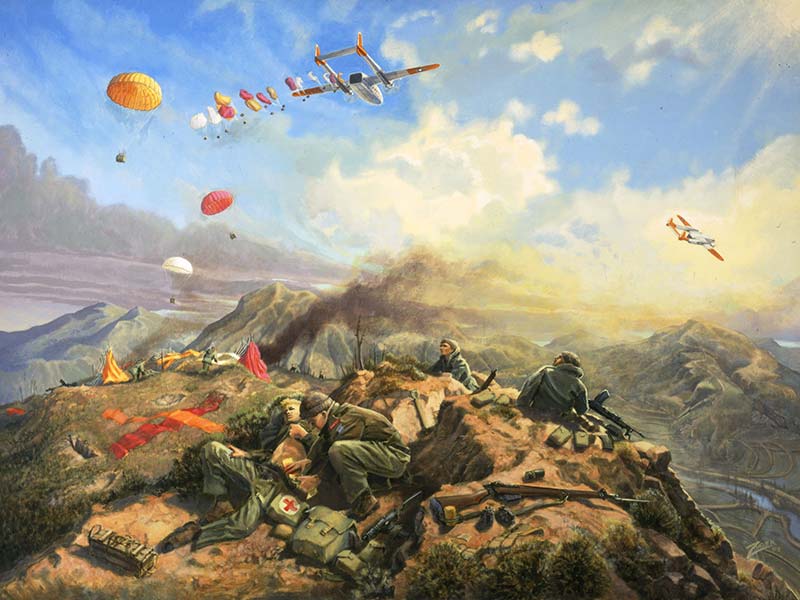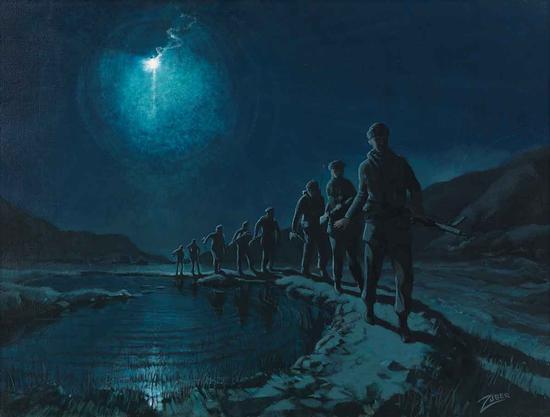Ted Zuber
Ted Zuber survived the Korean War and went on to become a well-known artist for the conflict.
Montreal, Quebec
Korean War

Table of contents
Early Life
Ted Zuber, born in Montreal on May 7, 1932, showed his skill for art at an early age. He said drawing pictures helped make himself clear to adults. His first painting, at age 12, showed a Swiss village based on a postcard from his grandfather.
Heroes Remember interview
View all of Ted Zuber's videosAnxious to Serve his Country - HTML5 Transcript/Captions
I grew up mostly during the Second World War
and radio was the big thing. And I can remember
the family, it's like an old movie I suppose.
And I can remember the family were all sitting
around the radio in the front room with dim lights.
And the program would be perfect because
we could only listen to it and conjure
up in our mind and, of course,
each one of us conjured the image
that suited us. So the programs
were perfect. And the one program
that was so outstanding, I remember
I can still feel a degree of emotion.
I think it was on Friday nights
but that's not important.
It was a Second World War story of
a Canadian Lancaster Bomber crew and
the heading of the program was,
“L for Lanky, Come in L for Lanky!�
And, of course, the sounds effects
of the engines, the engines of the
Lancaster Bomber and the fellows
speaking on the intercoms with each other,
it was magnificent.
I didn't like school very much.
I don't think I was a very good student.
Mathematics was my weakest. And, of course,
as an artist if I get creative with the numbers,
the answer is wrong, so what did I have,
you know? I learned to read very quickly.
The war was over.
We grew up during the war.
By that I was thirteen years old the very
day the war ended, the 7th of May and
what a birthday gift.
Privately inside ourselves, by that I mean
boys my age, we were sorry that it
ended so soon. Not because we wanted
people to die anymore. But we didn't get a
chance to show that we were men also.
And, of course, you can imagine the propaganda
during the Second World War. If you weren't in
uniform you didn't exist almost, you know.
When the Korean War came out suddenly we
had a chance to show that we too could be a man,
propaganda. And I had to join the paratroopers.
I was 136 pounds and they apologized.
It took 3 or 4 days to enlist right downtown,
Sherbrooke Street in Montreal and they called me,
the public selection officer or somebody
called me in and he said,
“I'm sorry Mr. Zuber but we cannot
allow you to goi into the paratroopers because
you don't weigh enough.� I guess the
parachute wouldn't function properly sort of thing.
And I looked at him and said,
“Surely to God they are not going to put
me out of an airplane in the first week,
they're gonna have me there for a while,
could they not put a few pounds on me?�
And he looked at me and he thought that
was brilliant and he said,
“That's good!� And they let me in.
I must say I was reflecting the psychology
of growing up in that war atmosphere.
A little footnote if I may interrupt myself.
On the troop ship crossing the Pacific to
go to Korea, we went first to Japan.
And we were coming into Japan and
I was one of the few people that was up on
deck about 5 o'clock that morning on this
old liberty boat troop ship, it was crowded
but early in the morning you would get a
bit of space up on the deck and there was
only two or three of us I think up there.
And as we approached the Japanese Islands
it was misty. Not foggy but misty and a
little island appeared, nobody on it,
a couple of maybe trees.
And as we were getting closer we are
heading for the Yokohama Harbour.
I will never forget this.
I suddenly was overwhelmed with a terror and
intellectually I knew what was happening to me
so I was like two people at the same time.
I was marvelling at how I was reacting
but the reaction was terrifying.
All those bloody posters depicting the Japanese
as buck tooth, big glass villains because
that's how they were depicted during the
propaganda of the Second World War
I was going into their home base.
I was honestly terrified.
It must have lasted for, I don't know,
for five or ten minutes.
My intellect finally woke me up and got me
out of it. But it was a terrifying,
terrible experience as we are coming into
that spooky early morning fog of the
mist of the Japanese Islands.
Signing up for the Korean War
When Zuber was 17, the Korean War started. He attempted to enlist, trying to become a paratrooper, but was initially turned down on the grounds he did not weigh enough. He replied, "Surely they can add a few pounds to me." The recruiter was won over by this way of thinking, and signed Zuber up. He was going to war.
Arrival in Korea
When he got to Korea, his unit traveled to Samichon Valley and Hill 186. While travelling, he was struck by the peaceful quiet of his new surroundings.
It was at that moment enemy shelling began.
Whatever heroic romanticism he had about war very quickly gave way to the reality of the situation. But, with striking speed, he and his unit adapted to the harsh conditions, and within a matter of weeks, they could weather the storm.

Holding at Kapyong by Edward Zuber
Becoming a Sniper
Zuber wanted the autonomy of a sniper, but when he originally applied for the position, he was told there were none available. This changed after the battles of Hill 355.
During that battle, the entire sniper unit had been wiped out by heavy shelling. These new vacancies meant Zuber got his wish and they moved to a new location called "The Hook" at the south end of the Samichon Valley. His primary duty was taking out enemy snipers.
Wounded
One evening, Zuber was resting in the tunnels under the hook when there was an accident. A young man who had been priming grenades accidentally set one off next to him. One man was killed and several wounded, including Zuber, who suffered shrapnel wounds that would cause him pain for the rest of his life.
He was rushed to a Norwegian MASH unit and then to a Canadian Field Dressing Station, but the need for snipers meant he had very little time to recuperate. After just a handful of days resting in Japan, he was back on the frontlines, sniper rifle in hand, and cast on his leg.
After the Korean War
Upon his return, the scars from the war quickly became apparent and, unfortunately, by the early 60's his marriage had fallen apart. He had become a photographer but soon set up a studio and dedicated himself to painting.
He made a decent living as a painter but, still, the Korean War was with him. To deal with the memories he started painting them but never showed the paintings to anyone, as he felt they were too personal.

Freeze by Edward Zuber
Official war artist
The Canadian War Museum was searching for more visual documentation of the War and discovered Zuber had been painting scenes from his experiences and approached him. First, a private buyer bought and donated the paintings to the Museum. Later, the Museum directly purchased several more of Zuber's Korean War paintings.
Like that, Zuber became the Canadian war artist for Korea.
In 1990, Zuber was asked to be the official Canadian war artist for the Gulf War. While he was hesitant to be in a war zone again, he did eventually accept and travelled to the Persian Gulf. He later went to Kosovo and Bosnia. In the early 2000s, Zuber was asked to do the same in Afghanistan, but by this time he had had been diagnosed with cancer.
Death
Zuber chose the time and place of his death and, on October 30, 2018, he passed in his workshop. His last painting, titled "Forever", had been finished for his second wife. It showed younger versions the two of them in Kayaks on the lake near their home.
Zuber's paintings still hang in the Canadian War Museum, and he has been recognized as a Canadian Heritage artist.
Where they served
Classroom materials
- Date modified:
